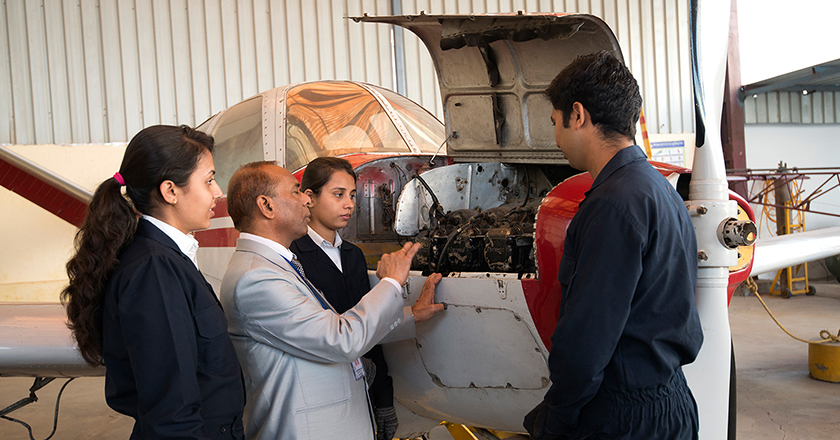Lesson THEME: Engineering: Maintenance
Maintenance Engineering is the discipline and profession of applying engineering concepts for the optimization of equipment, procedures, and departmental budgets to achieve better maintainability, reliability, and availability of equipment.
Maintenance, and hence maintenance engineering, is increasing in importance due to rising amounts of equipment, systems, machineries and infrastructure. Since the Industrial Revolution, devices, equipment, machinery and structures have grown increasingly complex, requiring a host of personnel, vocations and related systems needed to maintain them. Prior to 2006, the United States spent approximately US$300 billion annually on plant maintenance and operations alone.Maintenance is to ensure a unit is fit for purpose, with maximum availability at minimum costs. A person practicing Maintenance Engineering is known as a Maintenance Engineer.
Activity 1:
Listening exercise
Listen to the following 30-second sound clip:
Activity 2:
PICTURE

Describe what you see, in as much detail as possible.
Activity 3:
ARTICLE
The Duties of a Maintenance Engineer
by Alejandro Russell
A basic requirement for becoming a maintenance engineer is to attain a degree in an engineering field. Accumulating a few years of experience in the maintenance industry increases your chances of getting hired for such a position. The overall job for all maintenance engineers is to ensure that all workplace machines and processes are running smoothly. Therefore, such engineers are either performing preventive or emergency maintenance duties at their places of work.
Conducting Periodic Inspections
One of the core duties of any maintenance engineer is to conduct regular maintenance inspections of equipment, tools and machinery in the workplace. Some checks can only take place when the equipment or machines are not in use. Other inspections can be conduced while the machines under test are running, especially for production lines, where stopping the machines could spell losses for the company. During inspection, the engineer looks for worn-out, damaged or faulty parts and assesses the efficiency of production systems in plants or factories.
System Upgrades and Changes
Maintenance engineers recommend to company management any upgrades and changes that are needed to improve the performance of equipment and systems. Such recommendations are usually based on research and surveys of benchmark systems and technology. Maintenance engineers also outline things that need changing depending on the results of their own inspections carried out on company systems and equipment.
Troubleshooting
Another major role maintenance engineers play is troubleshooting broken down systems. Their employers expect them to know by heart everything about the technical systems in their company. Therefore, after identifying a problem, maintenance engineers should easily deduce its causes in the shortest time possible. After the engineer finds the cause, measures are put in to prevent the same problem from recurring.
Repairs and Replacement
Maintenance engineers repair any problems that they find after inspection or troubleshooting. They can either fix the faults themselves, or supervise other employees as they do it, since their status sometimes requires that they head a team, especially in companies where a single person cannot handle the amount of work. In case some parts in a system need replacing, it is the work of the maintenance engineer to request the exact spares needed and ensure proper installation. After the new installations, the maintenance engineer conducts a performance test to assess the efficiency of the new parts and system.
Only for future reference:
Activity 4:
Debate
Statement:
Preventative maintenance is a waste of money. Never fix something that is not broken.
Do you agree – why or why not?
Take a stand point and defend your opinion.
Activity 5:
QuOte:
“A machine’s breakdown true cost is sometimes difficult to measure.
A recent survey showed the actual cost for a breakdown is between four to fifteen times the maintenance costs.”
Please explain what your understanding is of this quote.
Do you agree or disagree with it? Why or why not?
Activity 6:
role play:
Scenario 1: You are the maintenance manager of a production company. Explain to your customer why production was stopped for 2 days – causing a delay in delivery to the customer.
Scenario 2: As the maintenance supervisor you are upset that the CFO (head of finance) has cut the preventative maintenance budget by 25%. Explain to her what the consequences of such a cut will be.
.
Activity 7:
IDIOMS:
English idioms, proverbs, and expressions are an important part of everyday English. Because idioms don’t always make sense literally, you’ll need to familiarize yourself with the meaning and usage of each idiom.
Learning to use common idioms and expressions will make your English sound more native, so it’s a good idea to master some of them.
Actions speak louder than words
Add fuel to the fire
A penny for your thoughts
Ball is in somebody’s court
Barking up the wrong tree
Activity 8:
PHRASAL VERBS:
Phrasal verbs open up a whole new world of possibilities for speaking English. They are phrases that give verbs completely different meanings. They are also used often in everyday conversation, which makes them important to know.
Log in / out
Hook up
Power up
Set up
Activity 9:
ASK QUESTIONS REGARDING THESE STATEMENTS:
A basic requirement for becoming a maintenance engineer is to attain a degree in an engineering field.
Engineers are either performing preventive or emergency maintenance duties at their places of work.
After identifying a problem, maintenance engineers should easily deduce its causes in the shortest time possible.
Activity 10:
headlines:
Skimping on maintenance, costs fleet owners
Rwanda and global airline body partner to improve air safety
“Iron Man” inspires robotic suit for nuclear workers in hazardous areas
Activity 11:
Homework:
Write a 200 word report on 2 advantages (pros) and 2 disadvantages (cons) of preventative maintenance.
This is a writing and speaking exercise.
